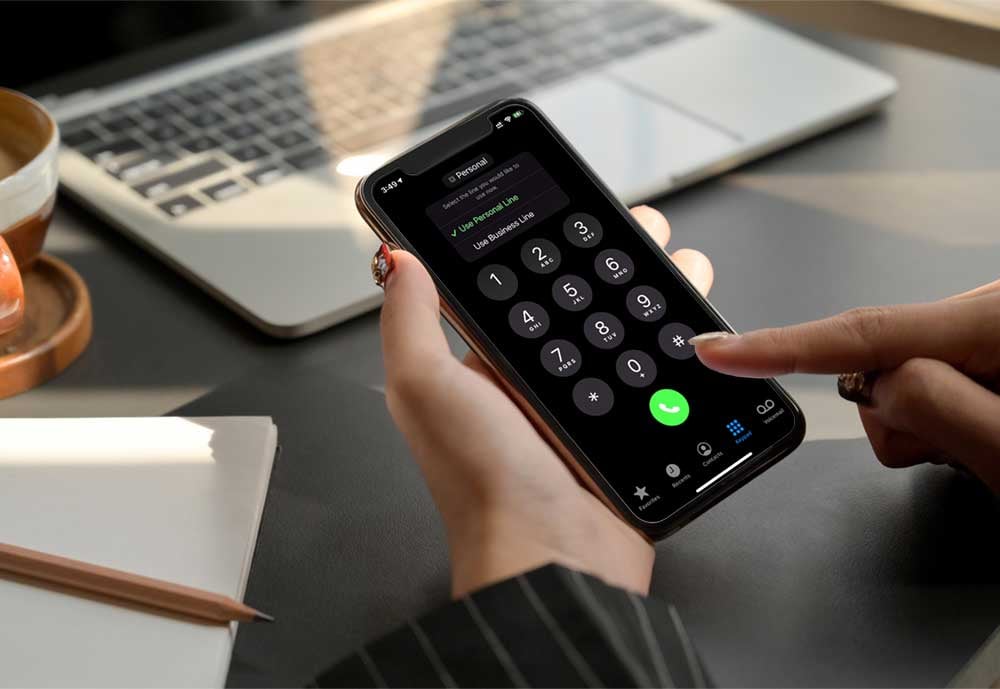April 24, 2023

The rapid mobilization of today’s business practices cannot be understated.
When it comes to business-to-business communications, the old-school landline is sliding into obsolescence. This is proved by the fact that an estimated 80% of business calls have at least one caller on a mobile phone.
Many of those mobile users are talking business using some sort of call-based mobile VoIP app supplied by a phone system vendor.
For the last decade or more, that’s been the common approach to “mobilizing” corporate communications as a solution for Mobile Unified Communications (UC).
UC platforms have been traditionally focused on desk phones and landline extensions. As demand has risen for mobile access to these platforms, vendors have developed on-phone apps that use VoIP for calls, creating a virtual phone extension on the mobile device.
For companies looking to make mobile communications available to their employees on the go, it seemed like a great solution. It allowed users to make business calls on their personal phones, which is much more economical than buying mobile phones for every employee.
But the industry has learned there are some showstopper issues with VoIP apps that make them nearly unusable for true business quality mobile UC.
Why Mobile VoIP Falls Short
Mobile VoIP apps are unreliable on mobile networks because they use a service provider’s data network, not the native voice service. The result is decidedly inferior call quality that is often not fit for important business communications with a customer.
Tango Networks President Andrew Bale offers the following scenario as an illustration:
Imagine you are waiting for your train at a crowded train station. Suddenly, there’s an announcement over the loudspeaker of a massive delay in train schedules.
Everyone immediately pulls out their mobile phones and opens travel apps to find ways around the delay. Many attempt to use their VoIP apps to call their customers saying they’ll be late.
When this surge in app and data usage happens, the data capacity of the cellular network carrying that traffic is quickly exhausted. Any business calls using VoIP apps will suffer very poor voice quality, and might even be dropped, if they go through at all.
But those callers using the native mobile voice service will still be able to make high quality calls, reach their contacts, and go about their business.
Why is there such a difference in the quality of native mobile voice compared to VoIP apps?
It boils down to the nature of mobile voice and mobile data services.
“Most of those people in the station will see four bars of signal strength on their phones but can’t make a voice call,” Andrew says. “The mobile data network doesn’t maintain quality of service for voice traffic over the data service, and there are many circumstances and occasions when data capacity and quality isn’t sufficient to ensure reliable voice calls with an app.”
Mobile data services on our cellular networks are purely “best effort.” There are no throughput or quality of service guarantees for data traffic – which all networked apps generate.
Locally available bandwidth is exhausted when app traffic spikes. That congestion means some traffic will not get through. If that traffic is your urgent call to a customer, then you are out of luck. “When you use a UC VoIP app on a mobile phone, it’s not a true voice call,” Andrew explains. “You might think it is, but the mobile network doesn’t. It’s just you browsing the internet, the same as everything else.”
But a person using the native green voice call button on the phone has a completely different experience. The “green button” on the phone is the trigger for a call that uses the dedicated cellular voice channel. Unlike the data channel, the voice channel features quality of service controls and dedicated bandwidth for real-time traffic like voice.

The result is a call that goes through, is clear and stable, and true business quality.
Andrew offers a simple piece of evidence that shows the stark difference between native mobile voice and best effort mobile VoIP.
Mobile service providers around the world ensure their voice channels are capable of carrying and connecting an emergency call at any time, accessible via 911 in the United States or 999 in England, for example. In many places it’s a legal requirement.
The voice channel provides that guaranteed connectivity of an emergency call. But the data channel used by VoIP simply does not. “There’s no obligation or even a minimal guarantee around data,” Andrew explains.
The Flap Over the App
The App-based approach to mobile UC boils down to a user experience that is far less than ideal.
As Andrew describes in his train station example, those trying to use VoIP apps for business calling routinely find the experience frustrating and the apps essentially unusable. “The more important mobile calling is to their job, the less satisfaction you get from people using apps on the phone,” Andrew explains.
But beyond call quality, the experience of using the app itself is not intuitive and leads to more frustration.
Just to place a business call, the user has to hunt for and open the designated VoIP app every time. If they want to use their car’s hands- free Bluetooth system or Bluetooth earbuds, many VoIP apps can’t connect or have spotty performance if they can.
More often than not, the user gives up on the app and uses the phone’s green call button, like they do for every personal call they make. It’s just easier – and as a result the UC app is ignored.
The result, Andrew points out, is that less than 7% of people who were assigned to use the app actually do so. The vast majority of mobile business calls are taking place using personal numbers and personal identities.
Tango Extend: App-less Mobile UC
Our Tango Extend service brings native mobile UC to any mobile phone. It is an industry first, integrating any mobile phone into a company’s UC platform for native business mobile communications.
That means the mobile’s green button is tied to the corporate platform and business calls using the business number utilize the mobile voice network.
The result? Users can operate mobile phones without VoIP Apps, using the intuitive and simple green button to place business calls. It works even on personal phones in a Bring Your Own Device program.
Every call is top quality native mobile voice, not best-effort VoIP, and business calls carry the company ID. Users can make hassle-free business calls with Bluetooth systems. Calls and texts can even be captured for mobile communications recording by the business while the user’s personal communications remain private and secure.
Tango Extend is covered by more than 100 patents for our unique approach to fixed-mobile convergence. The result is a dramatically superior user experience that solves the shortcomings of legacy approaches to mobile UC like VoIP apps.
“The mobile network is the most extraordinary machine that mankind has ever built,” Andrew concludes. “Tango Extend gives individual businesses unprecedented control over that machine. This represents the greatest advance in business communications technology in a generation.”
Get in touch today to see how Tango Extend will revolutionize mobile UC for your users.
